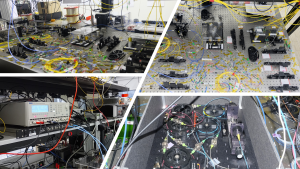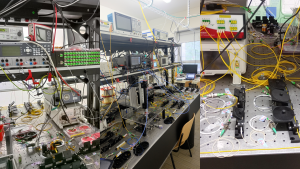Our laboratories are located at floor -1 of the Deparment of Physics of the University of Pavia.
We conduct both fundamental and applied research in the field of integrated photonics, quantum and nonlinear optics.
Here is a brief summary of what you can find inside our labs.
Probe stations for the characterization of integrated photonic circuits
Probe stations allows one to characterize the linear and nonlinear response of photonic integrated circuits (PIC). Typically, they feature a micrometric positioning stage for fiber coupling to integrated photonic waveguides located on the PIC. A microscope objective and a CCD camera are used to image the surface of the chip. Each PIC is thermally stabilized using closed-loop Peltier cells. Electrical probes can be used to reconfigure the device functionality by controlling the current which flows into on-chip micro-heaters.
Some of the highlights include:
- More than 6 probe stations, fully equipped for PIC characterization and running in parallel among different users
- Capabilities to couple light on-chip using lensed fibers, Ultra High Numerical Aperture fibers, fiber arrays and microscope objectives
- Up to 64 heaters simultaneously controlled on the same PIC

Laser sources and fiber amplifiers
Laser sources are, together with the PICs, the core elements of our experiments. In our labs, we use different types of lasers to to trigger the generation of nonclassical light from the PICs, or to probe their transmission spectra. Lasers are also routinely used in our research for stabilizing interferometers, for the synchronization of the arrival times of single photons and for precision-time measurements.
Some of the highlights include:
- Tunable continuos-wave laser sources in the C-band (1500-1565 nm) and O-band (1260-1360 nm)
- Tunable pulsed laser sources in the C-band, from <1 ps to 20 ps, 0.5-20 GHz repetition rate and > 10 mW average output power
- Erbium Doped Fiber Amplifiers (EDFA) up to 5 W of power
- A brand-new Titanium Sapphire laser, tunable from 600 to 1100 nm and continuos-wave operation
RF equipment, pulse shaping and frequency mixing
Electro-optic modulators can be used to amplitude-modulate the laser light at very high speed. Starting from a continuos wave laser, we use intensity-modulators to carve light pulses down to few hundreds of ps and in a wide range of repetition rates, where mode-locked lasers are difficult to operate. On the other hand, phase modulators allows us to coherently mix different optical frequencies without relying on weak optical nonlinearites, or to encode/decode information in coherent transceivers.
Some of the highlights include:
- Amplitude and phase modulators operating up to 20 GHz and 33 dBm of RF driving power
- RF generators operating from few mHz to 20 GHz, up to 23 dBm of power without amplification, and up to 8 coherent channels
- FPGA boards for signal conditioning and laser locking to optical cavities, microresonators and/or fiber-interferometers
- Phase locked loops modules for offset-frequency locking of different lasers, up to 10 GHz

Superconducting Nanowire Single Photon Detectors
Single photons generated from our PICs are detected with high efficiency by our battery of 8 superconducting nanowire single photon detectors (SNSPDs) operating at 0.8 K. All the laboratories are fiber-connected to the detector’s room, where the cryostat, the amplification electronics and the time-tagging modules are located. The time of arrival of the photons is marked by state-of-art electronic correlators, which can detect almost any coincidence pattern.
Some of the highlights include:
- A battery of 8 (6 optimized for NIR wavelengths + 2 for visible wavelengths) SNSPDs with 85% detection efficiency, < 50 ps of timing jitter, < 120 Hz of dark count rate, < 90 ns dead-time and 2 MHz of maximum rate of detections
- State-of-art time-tagging electronics, for coincidence measurements up to 8 photons
Experiments at cryogenic temperatures down to 4 K
Some of the PICs that we characterize in our labs need to work at cryogenic temperatures (around 4 K). Examples include single photon emitters based on semiconductor quantum dots or vacancy centers. We also test the optical properties of PICs at very low temperatures. The closed-circuit cryostat in our lab is exactly what allows us to conduct those tests.
Some of the highlights include
- A closed-circuit cryostat that can be cooled down to 4 K
- Excitation of the PICs through glass windows for the coupling external lasers
- This section is still under development and needs to be expanded.

